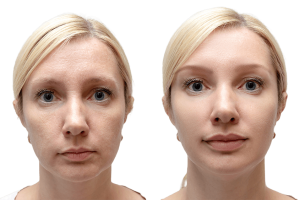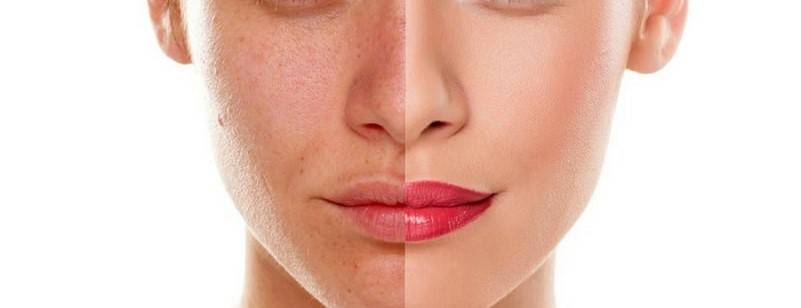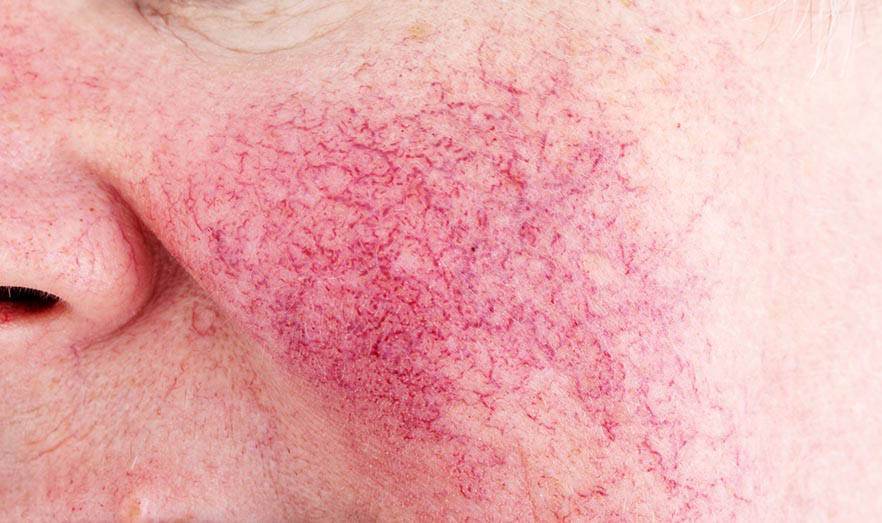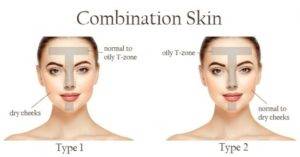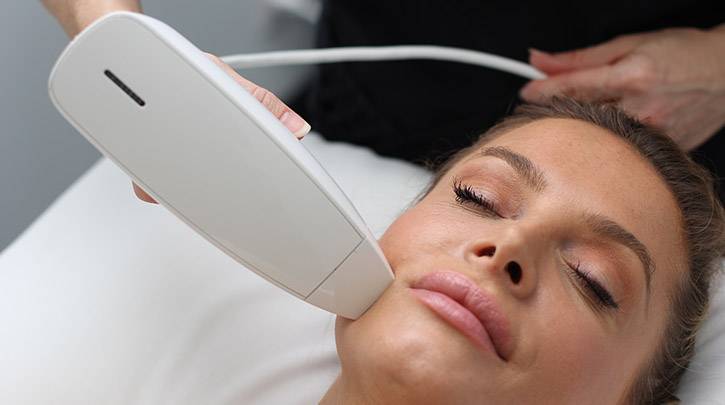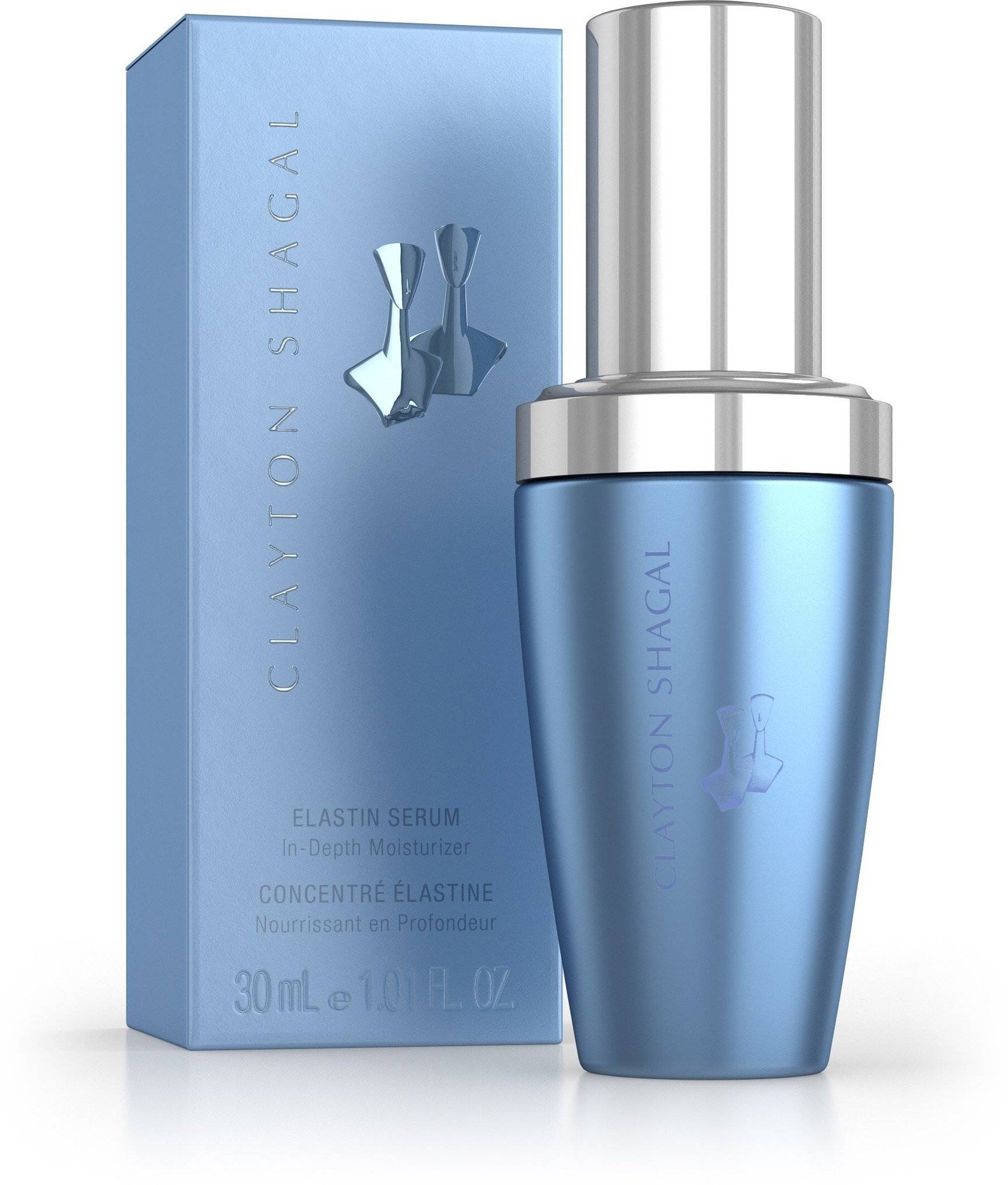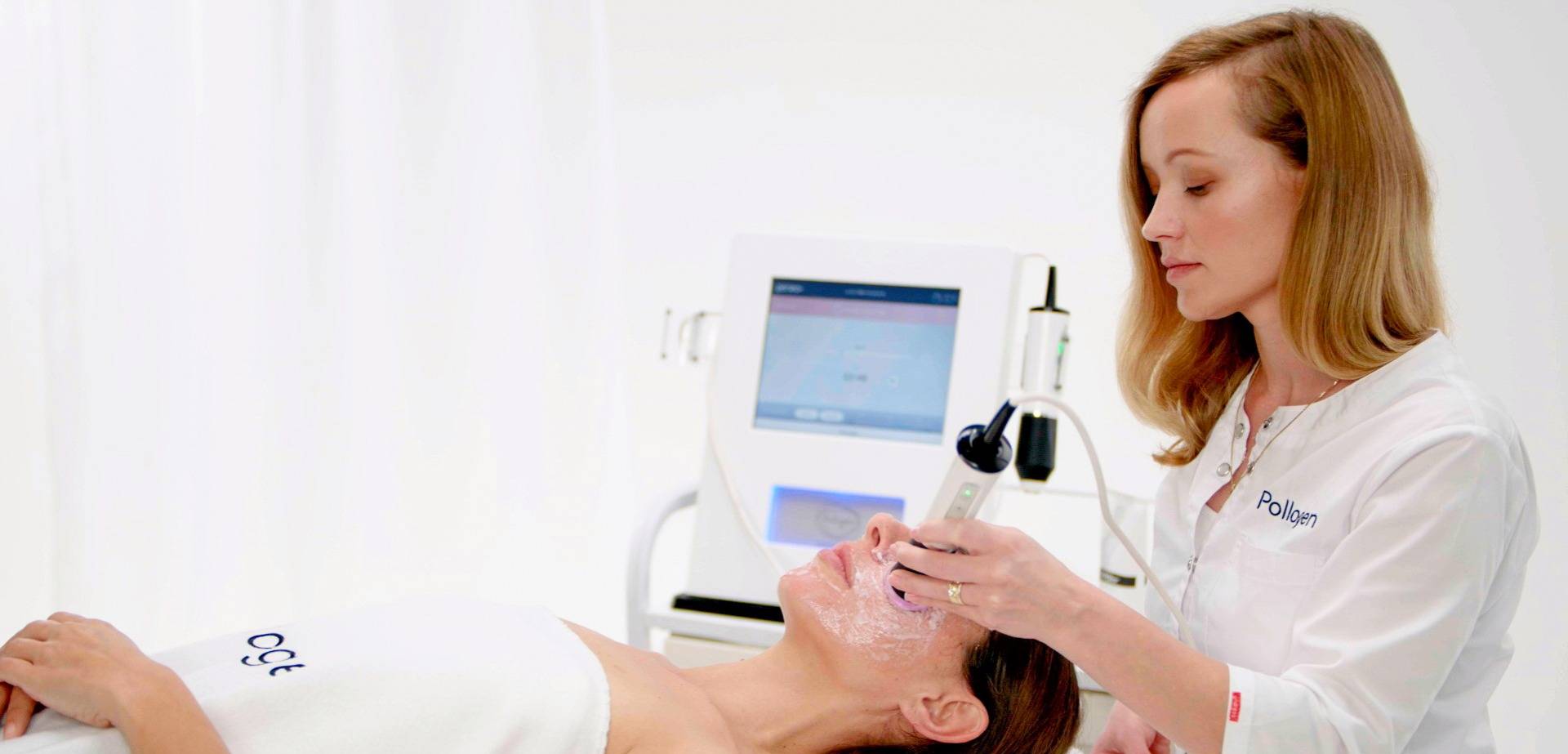The Selfology Skincare Guide
—SPRING EDITION—
A Comprehensive Skincare Guide for All Skin Types and Complexions
selfology.co/skincare
適合所有皮膚類型和膚色的綜合護膚指南 – 春季版
Table of Contents
≡ Rosacea
The best way to care for Rosacea
Φ 紅斑痤瘡 / 酒糟鼻
Table of Contents
What is rosacea?
Rosacea’s are small, red, pus-filled bumps on the skin that are present during flare-ups.
Typically, rosacea affects only skin on your nose, cheeks, and forehead.
What are the types of rosacea?
Four types of rosacea
Subtype one, known as erythematotelangiectatic rosacea (ETR), is associated with facial redness, flushing, and visible blood vessels.
Subtype two, papulopustular (or acne) rosacea, is associated with acne-like breakouts, and often affects middle-aged women.
Subtype three, known as rhinophyma, is a rare form associated with thickening of the skin on your nose. It usually affects men and is often accompanied by another subtype of rosacea.
Subtype four is known as ocular rosacea, and its symptoms are centered on the eye area.
Recommended Treatment for Rosacea
- Venus Viva Nano Fractional Radio Frequency Skin Resurfacing
- One Love IPL Treatment for Full Face & Neck with Choice of Selfology Healing Facial
- Four Advanced Medical Facial Treatments (w/ Super Collagen Healing Facial) Choose Any Combination from (a) One Love IPL Treatment for Full Face & Neck w/ Selfology Healing Facial OR (b) Diamond Polar Skin Tightening Treatment (30 mins)
- Hydrafill Facial – Needleless Mesotherapy;#Soothing Facial – Needleless Mesotherapy
- Timeless Facial – Needleless Mesotherapy
Recommended Rosacea/Product for Eczema
- Clayton Shagal Clinical Elasthy Extract
- Clayton Shagal Clinical Colhy Extract
- Clayton Shagal Hyaluronic Acid Serum
- Clayton Shagal Sensi Derm Cream
- Clayton Shagal Illumine Cream
- Clayton Shagal Cucumber and Avocado Mask
- Clayton Shagal Elastin Serum
- Clayton Shagal Oat Bran Scrub
- Clayton Shagal Gel Lotion Cleanser
- Clayton Shagal Milk Cleanser
- Clayton Shagal Collagen Serum
- Clayton Shagal Clinical Colhy Gel
- Clayton Shagal Clinical Elasthy Gel
- Clayton Shagal Collagen Gel Plus
- Clayton Shagal Elastin Gel Plus
- Clayton Shagal Collagen Gel
- Clayton Shagal Elastin Gel
- Clayton Shagal Hydra Derm Cream
- TIZO2® FACIAL PRIMER SUNSCREEN Non-Tinted Matte Finish SPF 40
- TIZO ULTRA ZINC BODY & FACE SUNSCREEN non-tinted dewy finish SPF 40
- Nano White Effect Brightening Gel Masque
≡ Sensitive Skin
The best way to care for Combination Skin
Φ 敏感型皮膚
Table of Contents
What is Sensitive skin?
Sensitive skin is a common condition and means your skin is more prone to reactions such as redness and itching. Most people who have sensitive skin notice occasional or frequent itching, burning and stinging of patches of skin. Sensitive skin is very treatable and may require a visit to the dermatologist.
While uncommon, sensitive skin can sometimes be a sign of a more serious condition, such as kidney disease, so it is always a good idea to see your doctor and get it checked out. Together, you will be able to develop a plan that usually includes relieving the itching or pain, treating the cause of the sensitivity and making a plan to protect your skin from irritants in the future.
What are the symptoms of sensitive skin?
Signs of sensitive skin come from the breakdown of your skin’s protective barrier. This can be caused by the environment, dehydration, or an underlying condition. Signs include:
- Rough, flaky patches
- Wrinkled, rough texture
- Redness
- Swelling
- Open sores or yellow crust over the skin
- Peeling skin
Sensitive skin can cause both objective signs and subjective symptoms. Objective signs are physical changes that your doctor can observe, such as redness, swelling or sores. They are changes to your skin’s protective barrier and are easy to observe from an outsider’s perspective.
The subjective symptoms refer to the feelings that sensitive skin can cause, like itching, burning and pain. They are just as real, but only felt or observed by you.
The Causes, Characteristics, and Diagnosis of Sensitive Skin
If you’re wondering, “Why does my skin hurt?” one of these reasons may be the culprit.
Contact Dermatitis
Contact dermatitis refers to the inflammation that can occur in your skin when it is exposed to an irritant.2 When the irritant, such as a strong fragrance in laundry detergent, comes in contact with your skin, it causes minor damage to the surface. In response, your body tries to protect itself from this perceived threat with an immune response.
This is similar to what you experience during an allergic reaction of the skin. Contact dermatitis is a common type of eczema.
Allergy
Dermatitis, or inflammation of the skin, can also be caused by an allergic response. When your skin has an allergic response, it means your immune system is in overdrive. When your skin touches an allergen, such as pollen when pulling weeds, your body tries to protect itself by releasing T-cells.2 This process can lead to redness and itching.
Rosacea
Rosacea is a skin condition that causes redness and swelling in the face and neck. It can start as flushing of the cheeks and sometimes spread to the ears. Doctors do not have an answer for what causes rosacea, but they know that people who are fair-skinned and have a family history are more at risk.
Acne
If you survived your teen years without a bout of acne, then you’re one of the lucky ones. Acne is a skin condition that causes pimples on the skin. It is the most common reason for seeing a dermatologist. There are plenty of myths for what causes it, but acne is triggered when your skin pores are clogged.
Dry Skin
It turns out the dry winter air may be enough to cause your skin sensitivity. According to the American Academy of Dermatology Association, excessively dry skin can put you at risk for developing another skin condition due to the irritation and itching.5
Other Causes
Less common causes of sensitivity can range from age to weather and everything in between. With age, your skin loses moisture and can become dry and cracked, putting you at risk for sensitive skin.
Certain medications, especially ones that treat hypertension, can cause dehydration and thus dry, irritated skin. Hormonal changes, such as those during the menstrual cycle, can also affect the skin. If you have ever received cancer treatment, you might have noticed patches of dry, itchy skin as a side effect.
As if you didn’t need one more reason to stay away from cigarettes—smoking speeds up skin aging and can lead to premature wrinkles and irritation. Pollution and some cosmetic products can also contribute.
Women Are More at Risk
Global studies have found that about 50% to 61% of women and 30% to 44% of men have experienced sensitive skin. One theory for why women are more prone to skin sensitivity is differences in skin thickness. Women may also be more at risk for dehydration and dry skin due to hormonal changes. These theories still require further research.
Serious Conditions
Most cases of sensitive skin can be easily treated, but it’s important to remember that skin irritation can sometimes be a sign of something more serious. Diseases that affect your skin or blood can sometimes manifest as sensitive skin. If you have any concerns about a new patch of sensitive skin, reach out to your doctor right away.
The following conditions may cause sensitive skin:
- Skin cancer
- Hodkin lymphoma
- Kidney disease
- Liver disease
- Shingles
- Multiple sclerosis
- HIV and other autoimmune conditions
Recommended Treatment for Sensitive Skin
Oceanic Facial
Soothing Facial – Needleless Mesotherapy
One Love Facial with Hydrating Eye & Lip Mask
Ocean Ninety – Full Body Massage & Active Collagen Facial
Recommended Product for Sensitive Skin
- Clayton Shagal Clinical Elasthy Extract
- Clayton Shagal Clinical Colhy Extract
- Clayton Shagal Elastin Serum
- Clayton Shagal Collagen Serum
- Clayton Shagal Clinical Colhy Gel
- Clayton Shagal Clinical Elasthy Gel
- Clayton Shagal Collagen Gel Plus
- Clayton Shagal Elastin Gel Plus
- Clayton Shagal Collagen Gel
- Clayton Shagal Elastin Gel
- Clayton Shagal Sensi Derm Cream
- Clayton Shagal Illumine Cream
- Clayton Shagal Cucumber and Avocado Mask
- Clayton Shagal Oat Bran Scrub
- Clayton Shagal Gel Lotion Cleanser
- Clayton Shagal Milk Cleanser
- Clayton Shagal Hydra Derm Cream
- Clayton Shagal Body Cream
- TIZO2® FACIAL PRIMER SUNSCREEN Non-Tinted Matte Finish SPF 40
- TIZO ULTRA ZINC BODY & FACE SUNSCREEN non-tinted dewy finish SPF 40
- Nano White Effect Brightening Gel Masque
≡ Dehydrated Skin
The best way to care for Dehydrated Skin
Table of Contents
What is Dehydrated Skin?
Dehydrated skin means that your skin is lacking water. It can be dry and itchy and perhaps dull looking, too.
Your overall tone and complexion may appear uneven, and fine lines are more noticeable.
While dehydrated skin can be a nuisance, it’s relatively easy to treat with the right lifestyle changes.
Treatment begins from the inside out to replenish and maintain hydration throughout your body.
Dehydrated skin can appear dry, but it’s not the same has having a dry skin type.
What are the symptoms of Dehydrated Skin?
The symptoms of dehydrated skin can include:
- a feeling of tightness
- mild to severe flaking and scaling
rough skin texture - sensitivity, itchiness and inflammation
Fine lines dehydration can cause the following symptoms:
- itchiness
- dullness
- darker under-eye circles
- sunken eyes
What Causes Dehydrated Skin?
There are numerous causes of dehydration, including:
- not drinking enough water
- weather and environment
- exposure to the sun, wind, cold,
- indoor heating and air conditioning can all cause moisture to evaporate from the skin
- sweating too much
- losing fluids through diarrhea or vomiting
- having a fever
Recommended Treatment for Dehydrated Skin
Hydrafill Facial – Needleless Mesotherapy
Timeless Facial – Needleless Mesotherapy
One Love Facial with Hydrating Eye & Lip Mask
One Love Facial, Full Body Exfoliation, Hydrating Eye & Lip Mask
Ocean Ninety – Full Body Massage & Active Collagen Facial
Ocean Sixty (O60) – Full Body Massage with Option of Selfology Healing Facial
Oceanic Facial
Recommended Resource/Product for Dehydrated Skin
Clayton Shagal Clinical Colhy Extract
Clayton Shagal Hyaluronic Acid Serum
Clayton Shagal Hydra One Cream
Clayton Shagal Hydra Light Cream
Clayton Shagal Cucumber and Avocado Mask
Clayton Shagal Moisturizing Mask
Clayton Shagal Bamboo and Honey Exfoliant
Clayton Shagal Milk Cleanser
Clayton Shagal Body Cream
Clayton Shagal Collagen Serum
TIZO2® FACIAL PRIMER SUNSCREEN Non-Tinted Matte Finish SPF 40
TIZO ULTRA ZINC BODY & FACE SUNSCREEN non-tinted dewy finish SPF 40
Engel Gesicht Hyaluronic Acid Collagen Sheet Face Mask
Nano White Effect Brightening Gel Masque
Clayton Shagal Hydra Derm Cream
Clayton Shagal Clinical Colhy Gel
Clayton Shagal Collagen Gel Plus
Clayton Shagal Collagen Gel
Clayton Shagal Idratense Cream
Clayton Shagal Nutri Sublime Cream
Clayton Shagal Illumine Cream
≡ Eczema
The best way to care for Eczema
Atopic Dermatitis
Φ 異位性皮膚炎, 濕疹
Table of Contents
What is Eczema?
Eczema, also called atopic dermatitis, is a common skin condition marked by itchy and inflamed patches of skin.
It’s often seen in babies and young children, appearing on the faces of infants. But eczema can come in a variety of types in children, teens, and adults. Read on to learn what causes the skin condition and how to treat its symptoms.
What are the symptoms of Eczema?
The main symptom of eczema is itchy, dry, rough, flakey, inflamed, and irritated skin. It can flare up, subside, and then flare up again.
Eczema can occur anywhere but usually affects the arms, inner elbows, backs of the knees, or head (particularly the cheeks and the scalp). It’s not contagious, and, in some cases, becomes less severe with age.
Other symptoms include:
intense itching
red or brownish-gray patches
small, raised bumps that ooze fluid when scratched
crusty patches of dried yellowish ooze, which can signal infection
thickened, scaly skin
Scratching eczema further irritates and inflames the skin. This can cause infections that must be treated with antibiotics.
What are the types of eczema?
When people refer to eczema, they usually mean atopic dermatitis, which is characterized as dry, itchy skin that often appears with a red rash. This is the most common and chronic type of eczema.
Other types include:
Contact dermatitis
Contact dermatitis is caused by contact with irritants. Burning, itching, and redness occur. The inflammation goes away when the irritant is removed.
Dyshidrotic dermatitis
Dyshidrotic dermatitis affects fingers, palms of the hands, and soles of the feet. It causes itchy, scaly patches of skin that flake or become red, cracked, and painful. The condition is more common in women.
Nummular dermatitis
Nummular dermatitis causes dry, round patches of skin in the winter months. It usually affects the legs. It’s more common in men.
What Causes Eczema?
The cause of eczema is not fully understood. However it is believed to be related to an overactive immune system that responds aggressively when exposed to irritants.
Eczema is sometimes caused by an abnormal response to proteins that are part of the body.
Normally, the immune system ignores proteins that are part of the human body and attacks only the proteins of invaders, such as bacteria or viruses.
In eczema, the immune system loses the ability to tell the difference between the two, which causes inflammation.
An eczema flare-up is when one or more eczema symptoms appear on the skin.
Common triggers of eczema flare-ups include:
- chemicals found in cleaners and detergents that dry out the skin
- rough scratchy material, like wool
- synthetic fabrics
- raised body temperature
- sweating
- temperature changes
- sudden drop in humidity
- stress
- food allergies
- animal dander
- upper respiratory infections
What are the risk factors of eczema?
Several factors can increase your risk of developing eczema.
Eczema is more common in children who suffer from asthma or hay fever, or adults who develop these conditions later, usually before the age of 30.
People with family members who have eczema are also at higher risk of developing the condition.
Recommended Treatment for Eczema
- Oceanic Facial
- Hydrafill Facial – Needleless Mesotherapy
- Soothing Facial – Needleless Mesotherapy
- One Love Facial with Hydrating Eye & Lip Mask
- Ocean Ninety – Full Body Massage & Active Collagen Facial
- Essential Facial
- Ocean Sixty (O60) – Full Body Massage with Option of Selfology Healing Facial
Recommended Resource/Product for Eczema
- Clayton Shagal Hyaluronic Acid Serum
- Clayton Shagal Cucumber and Avocado Mask
- Clayton Shagal Milk Cleanser
- Clayton Shagal Collagen Serum
- Clayton Shagal Hydra Derm Cream
- Clayton Shagal Clinical Colhy Gel
- Clayton Shagal Clinical Elasthy Gel
- Clayton Shagal Collagen Gel Plus
- Clayton Shagal Elastin Gel Plus
- Clayton Shagal Collagen Gel
- Clayton Shagal Elastin Gel
- Clayton Shagal Sensi Derm Cream
- TIZO2® FACIAL PRIMER SUNSCREEN Non-Tinted Matte Finish SPF 40
- TIZO ULTRA ZINC BODY & FACE SUNSCREEN non-tinted dewy finish SPF 40
≡ Sunspots/
Age Spots
The best way to care for Sunspots/Age Spots
(aka. Solar Lentigines / Liver Spots)
Φ 老年斑 / 曬斑
Table of Contents
What is Sunspots/Age Spots?
A Sunspots also also known as sun-induced freckle or solar lentigines.
It is a dark (hyperpigmented) lesion caused by natural or artificial ultraviolet (UV) light.
Solar lentigines may be single or multiple.
Solar lentigines are benign, but they do indicate excessive sun exposure, a risk factor that may rise to the development of skin cancer eventually if not properly cared for.
What are the symptoms of Sunspots/Age Spots?
Sunspots most commonly occur in older adults, particularly those who sunburn easily and fail to tan, but they may also occur in children.
Sunspots typically appear on areas exposed to natural or artificial UV light.
They appear as well-defined, light brown to black, flat spots. In people who have been treated with a form of UV light therapy called PUVA, sunspots may occur in areas of the skin not exposed to UV light.
What Causes Sunspots/Age Spots?
Exposure to UV radiation can cause Sunspots. You’re more likely to get this condition if you:
- have fair skin
- have been exposed to the sun a lot, or have had several sunburns
- tan indoors
- have had phototherapy or radiation therapy
- In other cases, an inherited syndrome can cause lentigines.
People of all ages and both genders can get sunspots.
Recommended Treatment for Sunspots/Age Spots
- OxyGeneo Facial
- Brightening Facial
Recommended Resource for Sunspots/Age Spots Skin
- Clayton Shagal Clinical Elasthy Extract
- Clayton Shagal Clinical Colhy Extract
- Clayton Shagal Hyaluronic Acid Serum
- Clayton Shagal Idratense Cream
- Clayton Shagal Sensi Derm Cream
- Clayton Shagal Nutri Sublime Cream
- Clayton Shagal Illumine Cream
- Clayton Shagal Cucumber and Avocado Mask
- Clayton Shagal AHA Exfoliating Mask
- Clayton Shagal Elastin Serum
- Clayton Shagal Mokaccino Mask
- Clayton Shagal AHA Scrub
- Clayton Shagal Bamboo and Honey Exfoliant
- Clayton Shagal Gel Lotion Cleanser
- Clayton Shagal Purifying Gel Cleanser
- Clayton Shagal Collagen Serum
- TIZO2® FACIAL PRIMER SUNSCREEN Non-Tinted Matte Finish SPF 40
- TIZO ULTRA ZINC BODY & FACE SUNSCREEN non-tinted dewy finish SPF 40
- Nano White Effect Brightening Gel Masque
- Clayton Shagal Clinical Colhy Gel
- Clayton Shagal Clinical Elasthy Gel
- Clayton Shagal Collagen Gel Plus
- Clayton Shagal Elastin Gel Plus
- Clayton Shagal Collagen Gel
- Clayton Shagal Elastin Gel
≡ Broken Capillaries
The best way to care for Broken Capillaries
(aka Telangiectasia)
Φ 毛细血管破裂
Table of Contents
What are Broken Capillaries?
Broken capillaries are also called “spider veins” — occur when they are dilated, or enlarged, just beneath your skin’s surface. This results in small, red lines that spread out into a web-shaped form. They can develop anywhere on the body, but they’re more common on the face and legs.
While harmless, Broken Capillaries can become a nuisance if they make you self-conscious. Spider veins are treatable and it all begins with exploring the underlying causes.
What are the symptoms of Broken Capillaries?
Broken capillaries are tiny blood vessels that have burst under the skin that can appear in any location on the body, but are especially noticeable in the nose area or other regions of the face.
The red veins take on the shape of spiderwebs, which is why they are also called “spider veins.”
What Causes Broken Capillaries and risk factors of Broken Capillaries?
Some people tend to develop spider veins more than others. The fact is that broken capillaries can happen to anyone at any age, including children. Your risk factors depend on the particular cause.
There are many causes of broken blood vessels on the face. They include:
Heredity and genetics
For unknown reasons, spider veins tend to run in families. Individual risk factors also increase with age.
Pregnancy
An increase in estrogen hormones during pregnancy can lead to broken blood vessels. Pregnancy-related spider veins heal on their own after delivery. Skin changes are common in pregnancy.
Rosacea
This common skin condition leads to excessive redness and flushing. With erythematotelangiectatic rosacea, broken blood vessels are common.
Sun exposure
Excessive sun exposure can enlarge your blood vessels. If you get a sunburn, the top layer of skin may peel and temporarily make some of the blood vessels in your face more noticeable.
Weather changes
Hot weather increases blood vessel dilation.
Environmental or chemical irritants.
Alcohol consumption
Moderate or occasional alcohol consumption can cause your skin to flush due to the enlargement of blood vessels. Binge drinking and heavy alcohol use can eventually lead to spider veins.
Injuries. Minor to significant injuries can lead to bruising. With bruises on your face, broken blood vessels may also be noticeable.
Vomiting or sneezing
Sudden, extreme pressure in your face from a violent sneeze or a vomiting spell can break the blood vessels in the skin.
Recommended Treatment for Broken Capillaries
- Soothing Facial – Needleless Mesotherapy;#Timeless Facial – Needleless Mesotherapy
- One Love Facial with Hydrating Eye & Lip Mask
Recommended Resource/Product for Broken Capillaries
- Clayton Shagal Clinical Elasthy Extract
- Clayton Shagal Clinical Colhy Extract
- Clayton Shagal Hyaluronic Acid Serum
- Clayton Shagal Sensi Derm Cream
- Clayton Shagal Cucumber and Avocado Mask
- Clayton Shagal Elastin Serum
- Clayton Shagal Oat Bran Scrub
- Clayton Shagal Milk Cleanser
- Clayton Shagal Collagen Serum
- TIZO2® FACIAL PRIMER SUNSCREEN Non-Tinted Matte Finish SPF 40
- TIZO ULTRA ZINC BODY & FACE SUNSCREEN non-tinted dewy finish SPF 40
- Nano White Effect Brightening Gel Masque
- Clayton Shagal Hydra Derm Cream
- Clayton Shagal Clinical Colhy Gel
- Clayton Shagal Clinical Elasthy Gel
- Clayton Shagal Collagen Gel Plus
- Clayton Shagal Elastin Gel Plus
- Clayton Shagal Collagen Gel
- Clayton Shagal Elastin Gel
≡ Melasma
The best way to (nearly) eliminate melasma
(aka Chloasma Faciei)
Φ 黄褐斑
Table of Contents
What is Melasma?
Melasma is a common acquired skin disorder that presents as a bilateral, blotchy, brownish facial pigmentation.
This form of facial pigmentation was previously called chloasma, but as this derives from the Greek meaning ‘to become green’, the term melasma (brown skin) is preferred.
Melasma is a common skin problem. The condition causes dark, discoloured patches on your skin.
It’s also called chloasma, or the “mask of pregnancy,” when it occurs in pregnant women. The condition is much more common in women than men, though men can get it too. According to the American Academy of Dermatology, 90 percent of people who develop melasma are women.
Medications and scented products — new targeted therapies for cancer and perfumed soaps, toiletries, and cosmetics may cause a phototoxic reaction to trigger melasma.
Researchers are examining the roles of stem cell, neural, vascular, and local hormonal factors in promoting melanocyte activation.
Who gets Melasma?
Melasma is more common in women than in men, with an onset typically between the ages of 20 and 40 years. Melasma is most common in people who tan easily or have naturally brown skin (Fitzpatrick skin phototypes III, IV). It is less common in people with fair skin (Fitzpatrick types I, II) or black skin (Fitzpatrick types V, VI).
What are the symptoms of Melasma?
Melasma causes patches of discoloration. The patches are darker than your usual skin color. It typically occurs on the face and is symmetrical, with matching marks on both sides of the face. Other areas of your body that are often exposed to sun can also develop melasma.
Brownish colored patches usually appear on the: cheeks, forehead, bridge of the nose, chin.
It can also occur on the neck and forearms. The skin discoloration doesn’t do any physical harm, but you may feel self-conscious about the way it looks.
If you notice these symptoms of melasma, see your healthcare professional.
They might refer you to a dermatologist, a doctor who specializes in treating skin disorders.
What Causes Melasma and risk factors of Melasma?
It isn’t totally clear what causes melasma. Darker-skinned individuals are more at risk than those with fair skin. Estrogen and progesterone sensitivity are also associated with the condition. This means birth control pills pregnancy, and hormone therapy can all trigger melasma. Stress and thyroid disease are also thought to be causes of melasma.
Additionally, sun exposure can cause melasma because ultraviolet rays affect the cells that control pigment (melanocytes).
Factors implicated in the development of melasma include:
Family history — 60% report affected family members
Sun exposure — ultraviolet and visible light promote melanin production.
Hormones — pregnancy and the use of oestrogen/progesterone-containing oral contraceptives, intrauterine devices, implants, and hormone replacement therapy, are implicated in one-quarter of affected women; thyroid disorders can be associated with melasma.
Recommended Treatment for Melasma
- Venus Viva 4D Diamond Polar™ Skin Tightening + Active Collagen Facial
- OxyGeneo Facial
- Brightening Facial Angie 13.56 MHz Thermocoagulation
- Anti-Aging & Firming Radio Frequency Facial
Recommended Resource/Product for Melasma
- Clayton Shagal Clinical Elasthy Extract
- Clayton Shagal Clinical Colhy Extract
- Clayton Shagal Idratense Cream
- Clayton Shagal Nutri Sublime Cream
- Clayton Shagal Illumine Cream
- Clayton Shagal Elastin Serum
- Clayton Shagal AHA Exfoliating Mask
- Clayton Shagal Mokaccino Mask
- Clayton Shagal AHA Scrub
- Clayton Shagal Bamboo and Honey Exfoliant
- Clayton Shagal Milk Cleanser
- Clayton Shagal Purifying Gel Cleanser
- Clayton Shagal Collagen Serum
- TIZO2® FACIAL PRIMER SUNSCREEN
- Non-Tinted Matte Finish SPF 40
- TIZO ULTRA ZINC BODY & FACE
- SUNSCREEN non-tinted dewy finish SPF 40
- Nano White Effect Brightening Gel Masque
- Clayton Shagal Clinical Colhy Gel
- Clayton Shagal Clinical Elasthy Gel
- Clayton Shagal Collagen Gel Plus
- Clayton Shagal Elastin Gel Plus
- Clayton Shagal Collagen Gel
- Clayton Shagal Elastin Gel
≡ Combination Skin
The best way to care for Combination Skin
Φ 混合型皮膚
Table of Contents
What is Combination Skin?
Combination skin is simply having oily skin in some areas of your face and dry skin in other areas. Typically, there’s a mix of oily and dry areas on different parts of your face, with the t-zone (forehead, nose, and chin) being slightly to very oily.
Whether you have oily areas only around the nose and center of the forehead and dry areas over the cheeks, jaw area, and along the hairline, what you do to lessen those problems is the same.
How do I Know if I Have Combination Skin
In general, the nose, chin, and forehead of those with combination skin have more active oil glands, which is why these areas may be prone to clogged pores. The cheeks, on the other hand, may have less active oil glands, which is why they may appear dry and flaky
Do You Notice These Issues?
If you have combination skin, you probably already know what the problems are, but here are the main ones you may experience:
• Clogged pores in the T-zone area
• Large pores in the T-zone area
• Shininess and oily skin in the T-zone area
• Dry, flaky and dull cheeks
• Cheeks and neck that are more sensitive to cleansers
What Causes Combination Skin?
A variety of factors can contribute to combination skin, but more often than not, it just comes down to the luck of the draw in terms of what you inherited from your parents. However, the types of skincare products you’re using can absolutely make it worse or even cause the problem. Read on to learn what you might unknowingly be doing to contribute to making combination skin more of an issue.
As you might already have suspected, using products that contain harsh or skin-aggravating ingredients will inevitably dry out some areas of your face while stimulating oil production in other parts (especially around the nose) that were already oily.
If you’re using the wrong products, you might actually be causing your combination skin. If you use the right products, you may still have some amount of oily skin, but at least you won’t have dry, rough skin underneath excess oil. Once you start using the right products, your skin can improve almost immediately, with the dry areas softened and smoothed and the oily areas less oily and red—plus minimized pores.
Recommended Treatment for Combination Skin
- One Love IPL Treatment for Full Face & Neck with Choice of Selfology Healing Facial
- OxyGeneo Facial;#Four Advanced Medical Facial Treatments (w/ Super Collagen Healing Facial) Choose Any Combination from (a) One Love IPL Treatment for Full Face & Neck w/ Selfology Healing Facial OR (b) Diamond Polar Skin Tightening Treatment (30 mins)
- Brightening Facial
- Purify Facial
- One Love Facial with Hydrating Eye & Lip Mask
- One Love Facial, Full Body Exfoliation, Hydrating Eye & Lip Mask;#Hydrafill Facial – Needleless Mesotherapy
- Venus Viva Nano Fractional Radio Frequency Skin Resurfacing
Recommended Rosacea/Product for Combination Skin
- Clayton Shagal Hyaluronic Acid Serum
- Clayton Shagal Ultra Matifying Cream
- Clayton Shagal Hydra Light Cream
- Clayton Shagal AHA Exfoliating Mask
- Clayton Shagal Mokaccino Mask
- Clayton Shagal Moisturizing Mask
- Clayton Shagal AHA Scrub
- Clayton Shagal Oat Bran Scrub
- Clayton Shagal Collagen Gel Plus
- Clayton Shagal Elastin Gel Plus
- Clayton Shagal Collagen Gel
- Clayton Shagal Elastin Gel
- Clayton Shagal Hydra One Cream
- Clayton Shagal Gel Lotion Cleanser
- TIZO2® FACIAL PRIMER SUNSCREEN Non-Tinted Matte Finish SPF 40
≡ Hyperpigmentation
The best way to treat Hyperpigmentation
Φ 色素沉著(面部)
Table of Contents
What is Hyperpigmentation?
Hyperpigmentation isn’t necessarily a condition but a term that describes skin that appears darker. It can: occur in small patches over large areas affect the entire body.
While increased pigmentation usually isn’t harmful, it can be a symptom of another medical condition. Learn about types of hyperpigmentation, causes, and how to treat it.
What are the types of Hyperpigmentations?
There are several types of hyperpigmentation, the common ones being melasma, sunspots, and post-inflammatory hyperpigmentation.
Melasma. Melasma is believed to be caused by hormonal changes and may develop during pregnancy. Areas of hyperpigmentation can appear on any area of the body, but they appear most commonly on the stomach and face.
Sunspots. Also called liver spots or solar lentigines, sunspots are common. They’re related to excess sun exposure over time. Generally, they appear as spots on areas exposed to the sun, like the hands and face.
Post-inflammatory hyperpigmentation. This is a result of injury or inflammation to the skin. A common cause of this type is acne.
What are the symptoms and risk factors?
Darkened areas on the skin are the main symptoms of hyperpigmentation. Patches can vary in size and develop anywhere on the body.
The biggest risk factors for general hyperpigmentation are sun exposure and inflammation, as both situations can increase melanin production. The greater your exposure to the sun, the greater your risk of increased skin pigmentation.
Depending on the type of disorder, other risk factors for hyperpigmented patches may include: oral contraceptive use or pregnancy, as seen with melasma darker skin type, which is more prone to pigmentation changes drugs that increase your sensitivity to the sunlight trauma to the skin, such as a wound or superficial burn injury.
What causes hyperpigmentation?
A common cause of hyperpigmentation is an excess production of melanin.
Melanin is a pigment that gives skin its color. It’s produced by skin cells called melanocytes. Several different conditions or factors can alter the production of melanin in your body.
Certain medications can cause hyperpigmentation. Also, some chemotherapy drugs can cause hyperpigmentation as a side effect.
Pregnancy changes hormone levels and can affect melanin production in some women.
The hyperpigmentation is a direct result of an increased level of a hormone in your body that results in increased melanin synthesis.
Excessive sun exposure can also cause an increase in melanin.
Recommended Treatment for Hyperpigmentation
- One Love IPL Treatment for Full Face & Neck with Choice of Selfology Healing Facial
- OxyGeneo Facial
- Four Advanced Medical Facial Treatments (w/ Super Collagen Healing Facial) Choose Any Combination from (a) One Love IPL Treatment for Full Face & Neck w/ Selfology Healing Facial OR (b) Diamond Polar Skin Tightening Treatment (30 mins)
- Angie 13.56 MHz Thermocoagulation
- Venus Viva 4D Diamond Polar™ Skin Tightening + Active Collagen Facial
- Brightening Facial
Recommended Product for Hyperpigmentation
- Clayton Shagal Clinical Elasthy Extract
- Clayton Shagal Clinical Colhy Extract
- Clayton Shagal Hyaluronic Acid Serum
- Clayton Shagal Idratense Cream
- Clayton Shagal Sensi Derm Cream
- Clayton Shagal Nutri Sublime Cream
- Clayton Shagal Illumine Cream
- Clayton Shagal AHA Exfoliating Mask
- Clayton Shagal Elastin Serum
- Clayton Shagal Mokaccino Mask
- Clayton Shagal AHA Scrub
- Clayton Shagal Bamboo and Honey Exfoliant
- Clayton Shagal Oat Bran Scrub
- Clayton Shagal Milk Cleanser
- Clayton Shagal Purifying Gel Cleanser
- Clayton Shagal Collagen Serum
- Clayton Shagal Clinical Colhy Gel
- Clayton Shagal Clinical Elasthy Gel
- Clayton Shagal Collagen Gel Plus
- Clayton Shagal Elastin Gel Plus
- Clayton Shagal Collagen Gel
- Clayton Shagal Elastin Gel
- TIZO ULTRA ZINC BODY & FACE SUNSCREEN non-tinted dewy finish SPF 40
- TIZO2® FACIAL PRIMER SUNSCREEN Non-Tinted Matte Finish SPF 40
- Nano White Effect Brightening Gel Masque
≡ Hyperpigmentation
The best way to treat Hyperpigmentation
Φ 色素沉著(面部)
Table of Contents
What is Hyperpigmentation?
Hyperpigmentation isn’t necessarily a condition but a term that describes skin that appears darker. It can: occur in small patches over large areas affect the entire body.
While increased pigmentation usually isn’t harmful, it can be a symptom of another medical condition. Learn about types of hyperpigmentation, causes, and how to treat it.
What are the types of Hyperpigmentations?
There are several types of hyperpigmentation, the common ones being melasma, sunspots, and post-inflammatory hyperpigmentation.
Melasma. Melasma is believed to be caused by hormonal changes and may develop during pregnancy. Areas of hyperpigmentation can appear on any area of the body, but they appear most commonly on the stomach and face.
Sunspots. Also called liver spots or solar lentigines, sunspots are common. They’re related to excess sun exposure over time. Generally, they appear as spots on areas exposed to the sun, like the hands and face.
Post-inflammatory hyperpigmentation. This is a result of injury or inflammation to the skin. A common cause of this type is acne.
What are the symptoms and risk factors?
Darkened areas on the skin are the main symptoms of hyperpigmentation. Patches can vary in size and develop anywhere on the body.
The biggest risk factors for general hyperpigmentation are sun exposure and inflammation, as both situations can increase melanin production. The greater your exposure to the sun, the greater your risk of increased skin pigmentation.
Depending on the type of disorder, other risk factors for hyperpigmented patches may include: oral contraceptive use or pregnancy, as seen with melasma darker skin type, which is more prone to pigmentation changes drugs that increase your sensitivity to the sunlight trauma to the skin, such as a wound or superficial burn injury.
What causes hyperpigmentation?
A common cause of hyperpigmentation is an excess production of melanin.
Melanin is a pigment that gives skin its color. It’s produced by skin cells called melanocytes. Several different conditions or factors can alter the production of melanin in your body.
Certain medications can cause hyperpigmentation. Also, some chemotherapy drugs can cause hyperpigmentation as a side effect.
Pregnancy changes hormone levels and can affect melanin production in some women.
The hyperpigmentation is a direct result of an increased level of a hormone in your body that results in increased melanin synthesis.
Excessive sun exposure can also cause an increase in melanin.
Recommended Treatment for Hyperpigmentation
- One Love IPL Treatment for Full Face & Neck with Choice of Selfology Healing Facial
- OxyGeneo Facial
- Four Advanced Medical Facial Treatments (w/ Super Collagen Healing Facial) Choose Any Combination from (a) One Love IPL Treatment for Full Face & Neck w/ Selfology Healing Facial OR (b) Diamond Polar Skin Tightening Treatment (30 mins)
- Angie 13.56 MHz Thermocoagulation
- Venus Viva 4D Diamond Polar™ Skin Tightening + Active Collagen Facial
- Brightening Facial
Recommended Product for Hyperpigmentation
- Clayton Shagal Clinical Elasthy Extract
- Clayton Shagal Clinical Colhy Extract
- Clayton Shagal Hyaluronic Acid Serum
- Clayton Shagal Idratense Cream
- Clayton Shagal Sensi Derm Cream
- Clayton Shagal Nutri Sublime Cream
- Clayton Shagal Illumine Cream
- Clayton Shagal AHA Exfoliating Mask
- Clayton Shagal Elastin Serum
- Clayton Shagal Mokaccino Mask
- Clayton Shagal AHA Scrub
- Clayton Shagal Bamboo and Honey Exfoliant
- Clayton Shagal Oat Bran Scrub
- Clayton Shagal Milk Cleanser
- Clayton Shagal Purifying Gel Cleanser
- Clayton Shagal Collagen Serum
- Clayton Shagal Clinical Colhy Gel
- Clayton Shagal Clinical Elasthy Gel
- Clayton Shagal Collagen Gel Plus
- Clayton Shagal Elastin Gel Plus
- Clayton Shagal Collagen Gel
- Clayton Shagal Elastin Gel
- TIZO ULTRA ZINC BODY & FACE SUNSCREEN non-tinted dewy finish SPF 40
- TIZO2® FACIAL PRIMER SUNSCREEN Non-Tinted Matte Finish SPF 40
- Nano White Effect Brightening Gel Masque
≡ Acne Rosacea
The best way to care for Acne Rosacea
Φ 玫瑰痤瘡 / 酒糟鼻
Table of Contents
What is Acne Rosacea?
Rosacea usually causes a persistent redness in the central part of your face. Small blood vessels on your nose and cheeks often swell and become visible.
Swollen, red bumps. Many people with rosacea also develop pimples on their face that resemble acne. These bumps sometimes contain pus.
Recommended Treatment for Acne Rosacea
- Venus Viva Nano Fractional Radio Frequency Skin Resurfacing
- One Love IPL Treatment for Full Face & Neck with Choice of Selfology Healing Facial
- Soothing Facial – Needleless Mesotherapy
- One Love Facial with Hydrating Eye & Lip Mask
- Essential Facial
- Oceanic Facial
Recommended Product for Acne Rosacea
- Clayton Shagal Hyaluronic Acid Serum
- Clayton Shagal Sensi Derm Cream
- Clayton Shagal Illumine Cream
- Clayton Shagal Hydra Light Cream
- Clayton Shagal Moisturizing Mask
- Clayton Shagal AHA Scrub
- Clayton Shagal Oat Bran Scrub
- Clayton Shagal Milk Cleanser
- TIZO2® FACIAL PRIMER SUNSCREEN Non-Tinted Matte Finish SPF 40
- TIZO ULTRA ZINC BODY & FACE SUNSCREEN non-tinted dewy finish SPF 40
- Nano White Effect Brightening Gel Masque
- Clayton Shagal Hydra Derm Cream
- Clayton Shagal Clear Skin Spot Treatment
- Clayton Shagal Collagen Gel
- Clayton Shagal Elastin Gel
≡ Cellulite
The best way to care for Cellulite
Φ 橘皮組織
Table of Contents
What is cellulite?
Cellulite is the dimpled-looking skin that commonly occurs in the thigh region. It forms when fatty tissue deep in the skin pushes up against connective tissue. It’s estimated that more than 85 percent of all women 21 years and older have cellulite.
Cellulite is also known as orange-peel skin due to its appearance and affects 80 to 90 percent of women.
Cellulite is a term for the formation of lumps and dimples in the skin.
Common names for cellulite are orange-peel skin, cottage-cheese skin, hail damage, and the mattress phenomenon.
Cellulite characteristics
Cellulite can affect both men and women, but it is more common in females, due to the different distributions of fat, muscle, and connective tissue.
Between of women may experience cellulite at some point in their lives.
Grades of cellulite
A cellulite severity scale, published in 2009, ranks the condition using three grades:
Grade 1, or mild: There is an “orange-peel” appearance, with between 1 and 4 superficial depressions, and a slightly “draped” or sagging appearance to the skin.
Grade 2, or moderate: There are between five and nine medium-depth depressions, a “cottage cheese” appearance, and the skin appears moderately draped.
Grade 3, or severe: There is a “mattress” appearance, with 10 or more deep depressions, and the skin is severely draped.
What causes cellulite?
The exact cause of cellulite is unknown, but it appears to result from an interaction between the connective tissue in the dermatological layer that lies below the surface of the skin, and the layer of fat that is just below it.
In women, the fat cells and connective tissue in this layer are arranged vertically.
If the fat cells protrude into the layer of skin, this gives the appearance of cellulite.
In men, the tissue has a criss-cross structure, which may explain why are less likely to have cellulite than women.
Some other factors appear to be linked to the chance of having cellulite.Hormonal factors and age.
Hormones likely play an important role in cellulite development. Estrogen, insulin, noradrenaline, thyroid hormones, and prolactin are part of the cellulite production process.
One theory is that as estrogen in women decreases in the approach to menopause, blood flow to the connective tissue under the skin also decreases.
Lower circulation means less oxygen in the area, resulting in lower collagen production. Fat cells also as estrogen levels fall.
These factors combine to makes the fat deposits more visible. As the fat under the skin protrudes through weakening connective tissue, the familiar dimpling effect results.
Age also causes the skin to becomes less elastic, thinner, and more likely to sag. This increases the chance of cellulite developing.Genetic factors.
Certain genes are required for cellulite development. Genetic factors can be linked to a person’s speed of metabolism, distribution of fat under the skin, ethnicity, and circulatory levels. These can affect the chance of cellulite developing.Dietary and lifestyle factors.
Cellulite is not caused by “toxins,” although a healthy lifestyle may help reduce the risk.
People who eat too much fat, carbohydrates, and salt and too little fiber are likely to have greater amounts of cellulite.
It may also be more prevalent in smokers, those who do not exercise, and those who sit or stand in one position for long periods of time.
Wearing underwear with tight elastic across the buttocks can limit blood flow, and this may contribute to the formation of cellulite.
Cellulite is more prevalent in people who have excessive adipose, but slim and fit people can have it too. It is more likely to happen after the age of 25 years, but it can affect younger people as well, including teenagers.
Recommended Treatment for Cellulite
Venus Legacy™ 4D Body Contouring & Cellulite Reduction《Venus Legacy™ 4D》
Radio Frequency Body Sculpting
Recommended Product for Cellulite
- Clayton Shagal Body Cream
- TIZO ULTRA ZINC BODY & FACE SUNSCREEN non-tinted dewy finish SPF 40
- Clayton Shagal Adipoderm Cream
- Clayton Shagal Collagen Gel Plus
- Clayton Shagal Elastin Gel Plus
- Clayton Shagal Collagen Gel
- Clayton Shagal Elastin Gel
On What Matters
Conditions & Care
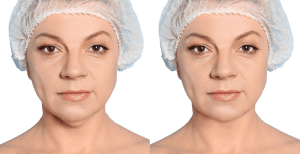
Loose Skin, Sagging Skin, Lack of Firmness
The best way to care for Loose Skin, Sagging Skin, Lack of Firmness Φ selfology.co/Skincare

Names at Selfology
You are a flower of wonder and delight
You fill my senses with your heavenly scent
You remind me of
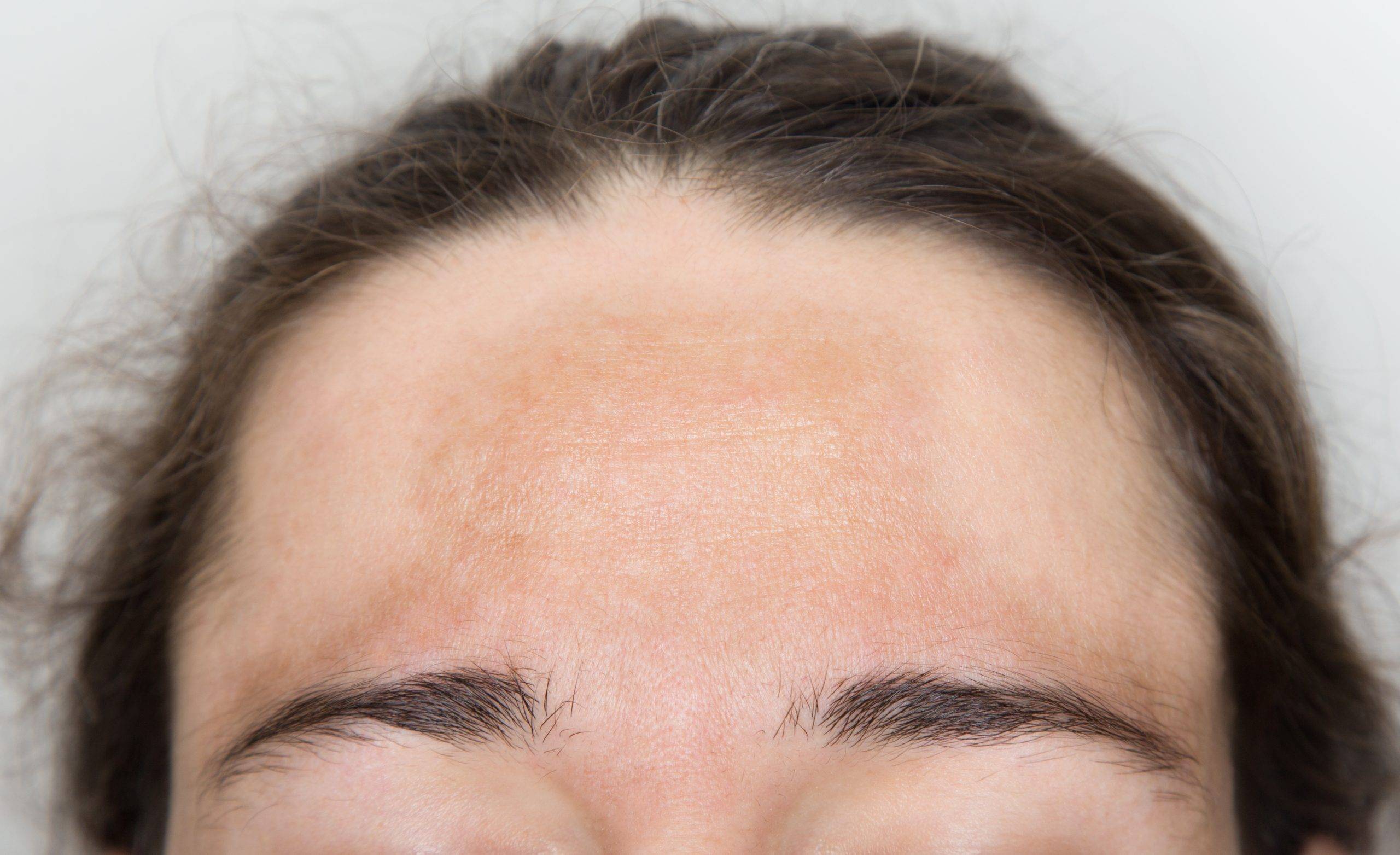
Hyperpigmentation
The best way to care for Hyperpigmentation Skin Φ selfology.co/Skincare


